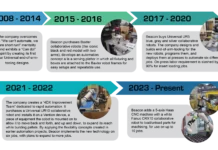by Shane Vandekerkhof, consultant/trainer, RJG, Inc.
When we ask customers what their most pressing quality issues are, short shots or non-filled parts are inevitably on the list. So why don’t we start by defining a short shot. A short shot is when a plastic part does not completely fill out. A portion of it is missing. A few issues can cause shorts, and the fix is not always that straightforward. Poor venting, material variations, improper machine settings, blocked gates or other possible mechanical failures can cause them. The fix to these issues are equally numerous – depending on the root cause of the problem.
One of the first steps in troubleshooting a short shot is to turn off second-stage pressure and time, and make what is referred to as a fill-only part. This will give you an idea of the flow pattern of the material inside the cavity and help with the troubleshooting process. Our goal is for this part to appear to be 95 to 98 percent full with no second stage being applied.
If the part is significantly smaller than that, we need to start with a root cause analysis of the problem.
- Verify the machine settings are correct by comparing them to the process setup document.
- Make sure there are not any mechanical problems. Check for any foreign material that possibly could be blocking the gates and impeding flow into the cavity.
- While the machine is down, it’s a good time to give the mold surface and vents a good wipe down to make sure they haven’t been clogged.
If everything seems to be in good working order, the problem simply could be material variation. The raw material coming into your plant will vary over time and may cause significant changes in your process. If this seems to be the cause of the short shot, then add material to the cavity. Again, the goal is to have this fill-only part 95 to 98 percent full. We recommend adjusting the shot size to achieve this, if necessary.
Next, put back the second stage pressure settings and take a look at the parts. Ideally we would have a target part weight to help us get back on track. If the short is still present or the part is underweight, then we can increase the second-stage pressure to drive more material into the cavity. As we do this, the short will hopefully disappear and the part weight will come up.
The ultimate goal is to follow a systematic troubleshooting procedure that allows everyone to work through the process in the same manner for the same reasons to fix the problem.
Shane Vandekerkhof is an RJG Consultant/Trainer. He is a certified Master MolderSM that is qualified to teach Scientific and DECOUPLED MOLDINGSM methodologies and techniques. He also has extensive field experience networking RJG’s eDART System and implementing cavity pressure sensor technology. For more information, visit www.rjginc.com.




